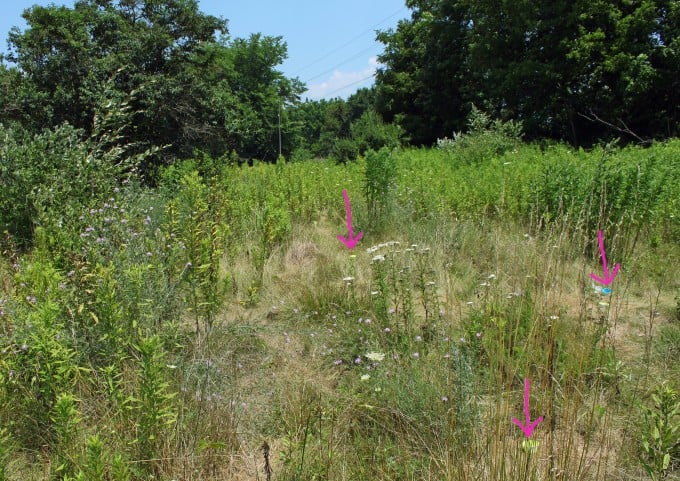
In my previous blog I talked about collecting bees. I am now going to talk about using another tool for collecting insects. This collection method uses bowl traps. The bowl traps are painted various colors to attract different bee species. For the past 3 years I have been using Silica flat yellow fluorescent and silica flat blue fluorescent paint for bowl colors. I also have used plain white bowls. There is an image above showing one of the bowls used for bowl trap collecting.
When using the bowl traps, you will need several items. You will need the bowls which you can make yourself. For information on purchasing the bowls and the paint to use for them, please contact me. I take approximately 15 – 20 bowls into the field with me along with a 40 ounce water bottle and a small container of Dawn dish soap. The soap is used to break the surface tension of the bee’s tarsus when they land. When placing bowls, I try to stamp the area or pull out grass so that the bowl sits as level as possible. It is important to pick locations that the bees will be able to see easily. There is an image below with arrows pointing to bowls set up in the field. I try to keep them at least 3 feet apart. Once you have placed all the bowls wait a day or so to go back to collect what is in the traps. I usually return the next day to collect them because it limits bowls spilled by animals or dried/overfilled by weather.

When you retrieve the bowls, separate the bowls by color and place them into individually marked bottles filled with 70% ethanol or alcohol. Once the bees are placed in alcohol, they can be stored for a period of time. When it is time to process the samples, I shake the bees in the alcohol to remove soap and repeat this step with water until the bees look clean and un-matted. Once clean, set the bees on toilet paper to dry momentarily until they are dry enough to wrap. I then wrap the bees in a single square of toilet paper. Once I have enough of the bees wrapped, I place them in a box and set them in front of a fan for a few hours to dry. If the bees still look matted you can rewash them with water and repeat the process. There are other drying methods for bowl trap bees but I have developed this method from working with what I had available. The images below showing part of the drying process. Once the bees are dried they can be pinned and later identified. I will cover pinning bees in my next blog.
